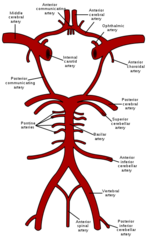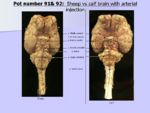CNS Vasculature - Anatomy & Physiology
Circle of Willis
Blood is supplied to the brain from a ventral arterial supply in all species, from a circle of arteries called the Circle of Willis (also called the cerebral arterial circle or arterial circle of Willis) which lies ventrally to the hypothalamus where it forms a loose ring around the infundibular stalk. Although the appearance of the circle of Willis is fairly constant amongst mammals, the sources of blood supply to the circle and the direction of flow around the circle are very species specific. Blood is supplied to the brain by the internal carotid artery in dogs and horses whilst in other domestic species the main blood supply is from branches of the maxillary artery. The Circle of Willis is made up of five main pairs of vessels;
- Rostral Cerebral Arteries: supply the medial aspect of the cerebral hemispheres.
- Middle Cerebral Arteries: supply the lateral and ventrolateral aspects of the cerebral hemispheres.
- Caudal Cerebral Arteries: supply the occipital lobes.
- Rostral Cerebellar Arteries: supply the rostral aspects of the cerebellum
- Caudal Cerebellar Arteries: supply the caudal and lateral aspects of the cerebellum.
The arrangement of the Circle of Willis means that if one part of the circle becomes blocked or narrowed (stenosed), or one of the arteries supplying the circle is stenosed, blood flow from the other blood vessels can continue to provide a continuous supply of blood to the brain.
Blood Supply to the Circle of Willis
In order to provide details of the species differences regarding blood supply to the brain, it is necessary to highlight the main areas of anatomy that are important within and around the circle of Willis. The following informatino is very generalised and is used to provide knowledge and background to the species specifics given below.
The main blood supply to the circle is via the paired internal carotid arteries and the basilar artery. The basilar artery receives blood from the ventral spinal artery and the vertebral artery (the vertebral artery is a branch of the subclavian artery running through the vertebral foramina of C1 - C6). The internal carotid artery receives blood supply from the external carotid artery, the common carotid artery and in some species also the vertebral artery. In some species
Note: The basilar artery and middle cerebral arteries, though they supply the brain, are not considered part of the circle.
Rete Mirable
The brain is particularly susceptible to increased blood temperature and to protect the brain from any potential heat stress a number of species have developed protective mechanisms with the ability to selectively cool the brain. This protective system is often referred to as the Rete Mirable.
The Rete Mirable is a complex network of arteries and veins lying very close to each other and depends on a countercurrent blood flow between the arterioles and venuoles (blood flowing in opposite directions). It exchanges heat, ions, or gases between vessel walls so that the two bloodstreams within the rete maintain a gradient. The image shows the countercurrent exchange in the carotid rete mirable (carotid rete) of a sheep controlling the temperature of blood supplied to the brain.
Species Differences
The blood supply to the brain has major differences depending on species. Across all species, there are four 4 potential channels to facilitate blood supply to the Circle of Willis. These are;
- Internal carotid artery
- Basiliar artery
- The anastomosing ramus from the maxillary artery to the internal carotid artery
- The connection of the vertebral artery to the internal carotid artery
Dog and Man (and many other species)
The circle of Willis in the dog is supplied from three sources; paired internal carotid arteries laterally and the basilar artery caudally. The internal carotid artery is a terminal branch of the common carotid artery. The internal carotid artery blood reaches all of the cerebral hemisphere except for it's most caudal part. Vertebral blood supplies the the remainder of the cerebral hemisphere and the rest of the brain. Vertebral arteries are responsible for almost all supply to the occipital lobes of the cerebral hemisphere in the dog.
Sheep and Cat
Only channel 3 supplies the arterial circle and unlike in the dog, this channel has a rete mirable. Channel 2 carries blood away from the arterial circle. Maxillary blood is distributed to all of the brain except the caudal part of medulla oblongata, which is supplied by vertibral blood.
Ox
Channels 3 and 4 both supply the arterial circle and each has a rete mirable. Channel 2 carries blood away from the arterial circle. A mixture of maxillary and vertebral blood reaches all parts of the brain.


